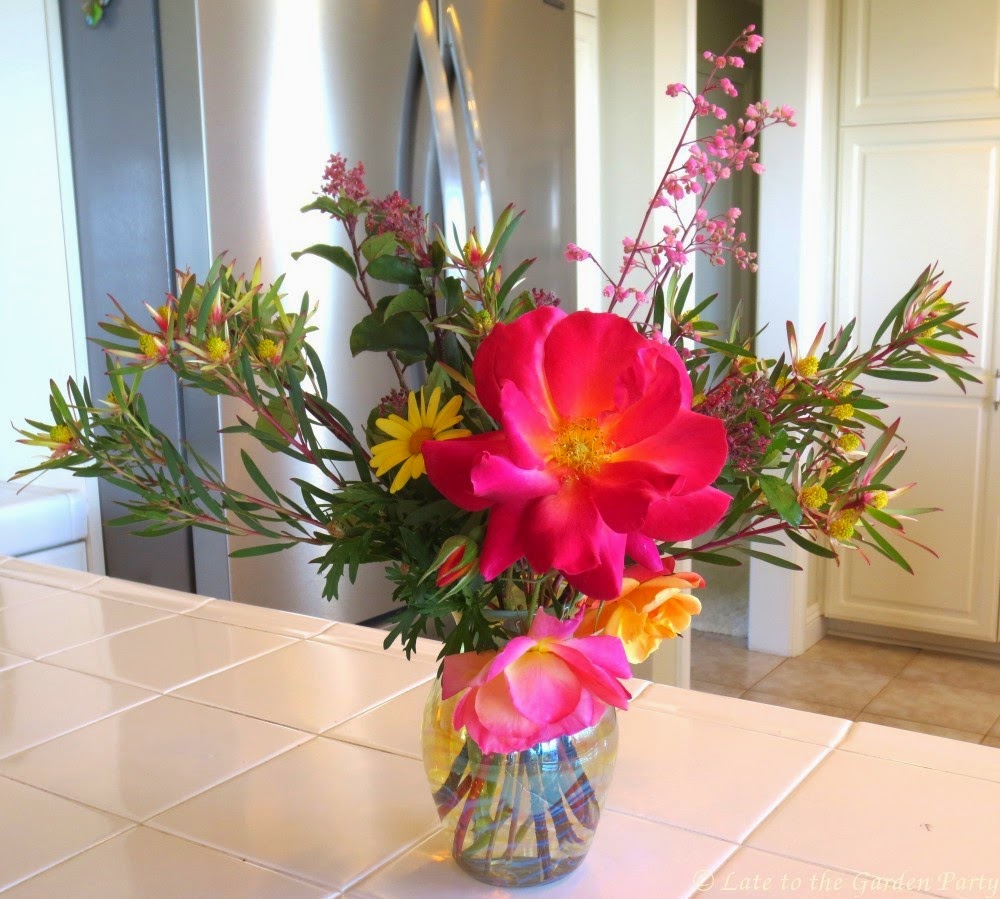If my garden is any indication, January seems to be the month of the daisy. But before I provide the round-up of the daisies currently in bloom, I want to highlight my favorite flower this month,
Grevillea 'Peaches & Cream.' I took a ridiculous number of photos of the flowers on this plant at various stages in their development but I'll share just one.
 |
| The flower of Grevillea 'Peaches & Cream' starts out pale yellow and takes on its peach tones as it matures |
A few other
Grevillea are also in bloom, two of which are particularly eye-catching, despite their very small flowers.
 |
| The flower of G. alpina x rosmarinifolia is much smaller than it appears in this photo but perfect |
 |
| G. lavandulacea 'Penola' is a large plant (over 6 feet tall) that produces tiny rose-red blooms |
Among the daisies, my current favorite is
Arctotis 'Pink Sugar,' which is providing the majority of floral color in my front garden right now.
Yes, those
Arctotis flowers are bright! But I recently found another plant with blooms that are just as bright, albeit smaller.
 |
| Correa pulchella 'Flamingo' |
But back to the daisies. As a genus, the
Osteospermum are dominant in the daisy category as virtually every one in my garden is blooming (and I have a LOT of
Osteospermum).
 |
| Shown here, clockwise starting with the larger photo on the left are: Osteospermum ecklonis '3D Silver,' O. 'Berry White,' O. 'Spoon Pink,' O. 'Serenity Bronze', and O. 'Blue-eyed Beauty' |
Yellow daisies of various types also seem to be everywhere, perhaps due to the fact that I love yellow.
 |
| Clockwise from the top left are: Argyranthemum frutescens 'Butterfly,' annual Leucanthemum paludosum, Euryops 'Sonnenschein,' and a blooming Aeonium (no ID) |
There are also multi-color daisies.
 |
| At top is Gaillardia aristata 'Gallo Peach' and on the bottom (left to right) are Gazania hybrid 'Kiss Frosty White Flame' and Gaillardia x grandiflora 'Goblin' |
And purple daisies.
 |
| Aster x frikartii 'Monch' |
Blue and purple blooms of other kinds are also well-represented this January.
 |
| Ageratum houstonianum 'Blue Horizon' |
 |
| Anemone coronaria 'Mona Lisa Deep Blue' is much bluer than in looks here in the glare of the sun |
 |
| Hebe speciosa 'Variegata' |
 |
| The first grape hyacinth (no ID, possibly Muscari aucheri) |
 |
| The first blooms of the annual Nemophila menziesii |
 |
| Primula obconica, recently purchased to fill a temporary hole in the shady section of my new front garden |
 |
| Solanum xantii, a California native that never shows up as well in pictures as it does in the garden |
There are flowers that attract wildlife.
 |
| All 5 Arbutus 'Marina' trees are still in full flower and well-loved by bees and hummingbirds |
 |
| The hummingbirds and bees also love Cuphea x ignea 'Starfire Pink' but apparently do does this sulphur yellow butterfly |
 |
| Ribes viburnifolium also attracts hummingbirds in flower |
Other than Alyssum (
Lobularia maritima), white flowering plants are in relatively short supply right now but there are a couple.
 |
| Cyclamen (no ID) |
 |
| Nandina domestica |
I even have an orchid blooming in my home office.
 |
| Miltassia Shelob 'Tolkein' |
What's surprising is that many of the blooms that were present last January haven't yet made an appearance. Some, like the
Bauhinia x blakeana (aka Hong Kong orchid tree) and the
Narcissus got rained out - the
Bauhinia was gorgeous last week but this week all the petals lie on the ground. There are no sign of flowers on the
Ceanothus hedges, the
Erysimum or the hardy
Geraniums. With the exception of the
Pelargonium peltatum (ivy geraniums), which are blooming but which I didn't photograph this month, none of the
Pelargoniums are blooming yet either. Other plants, like
Leucanthemum x superbum have produced a flower here and there but they don't seem ready to take off yet. I expect this may be the result of the colder temperatures we had in December.
That's it for my Bloom Day summary. Thanks for visiting. Check in with Carol at
May Dreams Gardens, the host of the monthly event that is Bloom Day, to see what's happening in her Indiana garden and to find links to other Bloom Day posts from around the world.
All material
© 2012-2015 by Kris Peterson for Late to the Garden Party































































